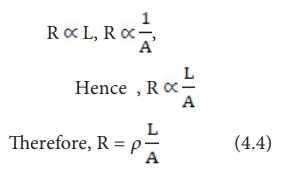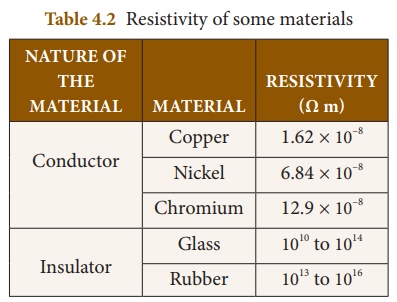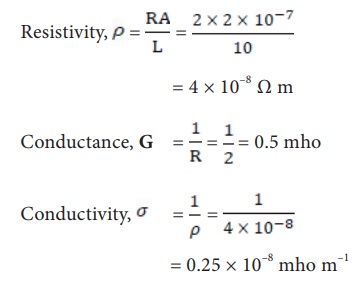Definition, Formula, Solved Example Problems - Electrical Resistivity Electrical Conductivity | 10th Science : Chapter 4 : Electricity
Chapter: 10th Science : Chapter 4 : Electricity
Electrical Resistivity Electrical Conductivity
ELECTRICAL RESISTIVITY
ELECTRICAL CONDUCTIVITY
1. Electrical Resistivity
You can verify by doing
an experiment that the resistance of any conductor ŌĆśRŌĆÖ is directly proportional
to the length of the conductor ŌĆśLŌĆÖ and is inversely proportional to its area of
cross section ŌĆśAŌĆÖ.

Where, Žü (rho) is
a constant, called as electrical resistivity or specific resistance of the
material of the conductor.
From equation (4.4), Žü = RA/L

If L = 1 m, A = 1 m2
then, from the above equation Žü = R
Hence, the electrical
resistivity of a material is defined as the resistance of a conductor
of unit length and unit area of cross section. Its unit is ohm
metre.
Electrical resistivity
of a conductor is a measure of the resisting power of a specified material to
the passage of an electric current. It is a constant for a given material.
2. Conductance and Conductivity
Conductance of a
material is the property of a material to aid the flow of charges and hence,
the passage of current in it. The conductance of a material is mathematically defined
as the reciprocal of its resistance (R). Hence, the
conductance ŌĆśGŌĆÖ of a conductor is given by
G = 1/R (4.5)

Its unit is ohmŌĆō1.
It is also represented as ŌĆśmhoŌĆÖ.
The reciprocal of
electrical resistivity of a material is called its electrical conductivity.

Its unit is ohmŌĆō1
metreŌĆō1 . It is also represented as mho metreŌĆō1. The
conductivity is a constant for a given material. Electrical conductivity of a
conductor is a measure of its ability to pass the current through it. Some
materials are good conductors of electric current. Example: copper, aluminium,
etc. While some other materials are non-conductors of electric current
(insulators). Example: glass, wood, rubber, etc.
Conductivity is more for
conductors than for insulators. But, the resistivity is less for conductors
than for insulators. The resistivity of some commonly used materials is given
in Table 4.2.

Solved Problem
The resistance of a wire
of length 10 m is 2 ohm. If the area of cross section of the wire is 2 ├Ś 10ŌĆō7
m2, determine its (i) resistivity conductance and (iii) conductivity
Solution:
Given: Length, L = 10 m,
Resistance, R = 2 ohm and Area, A = 2 ├Ś 10ŌĆō7 m2

Related Topics